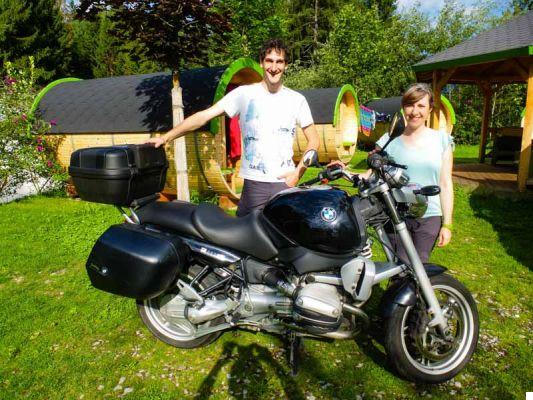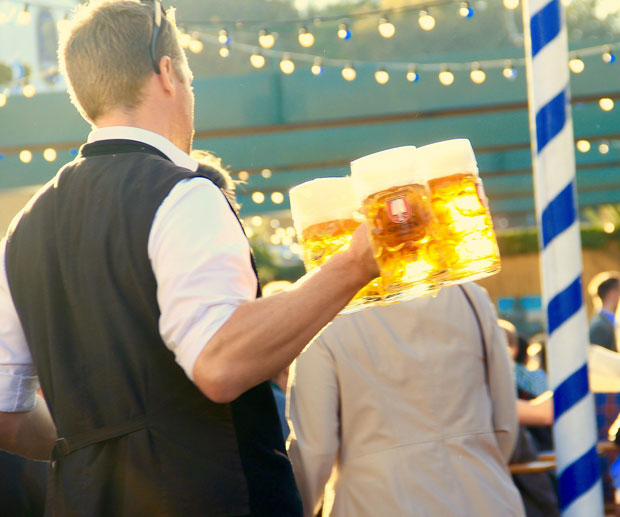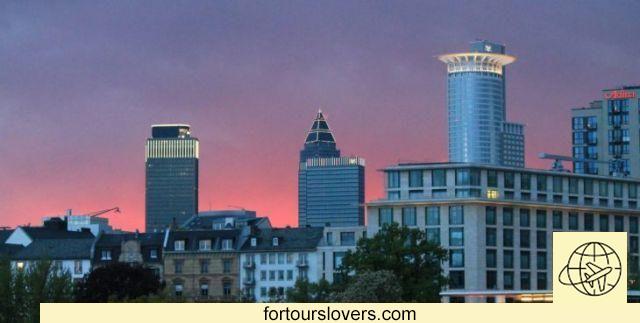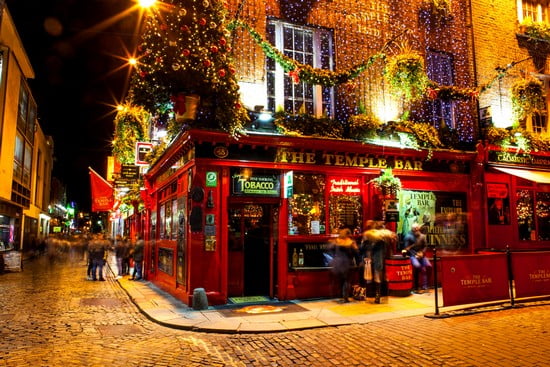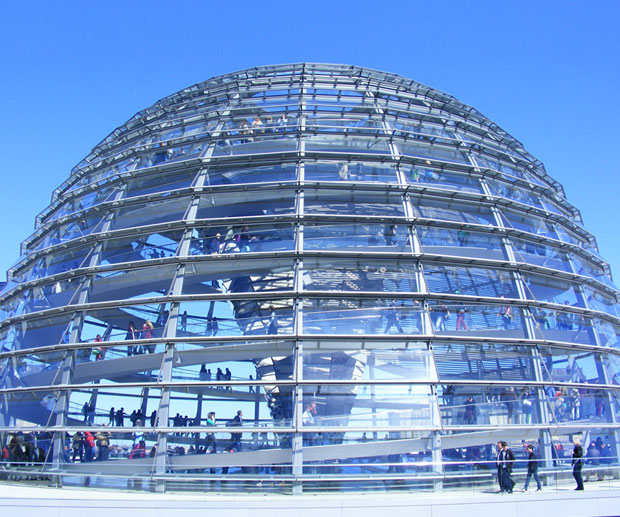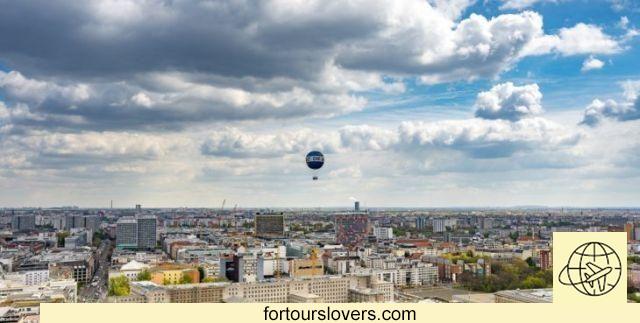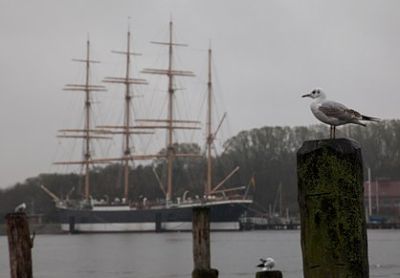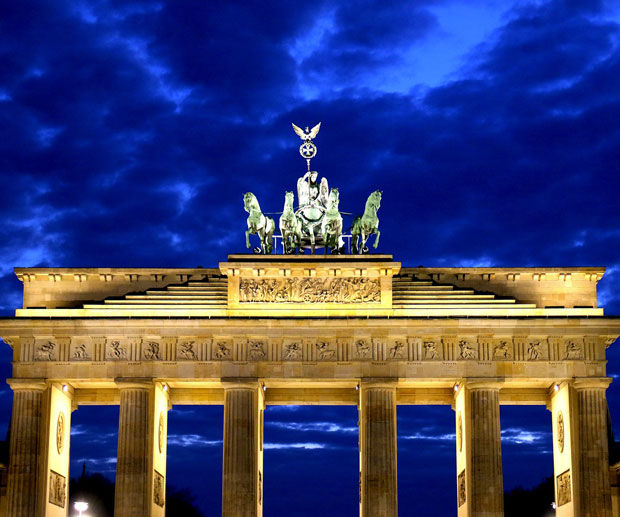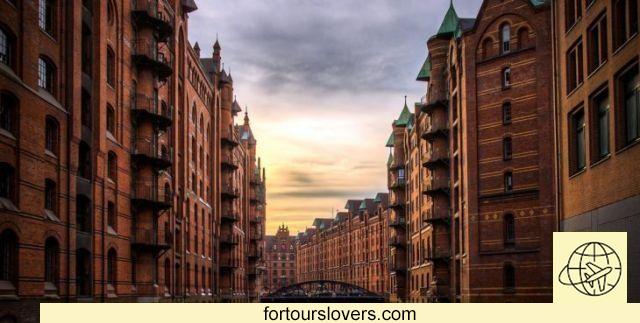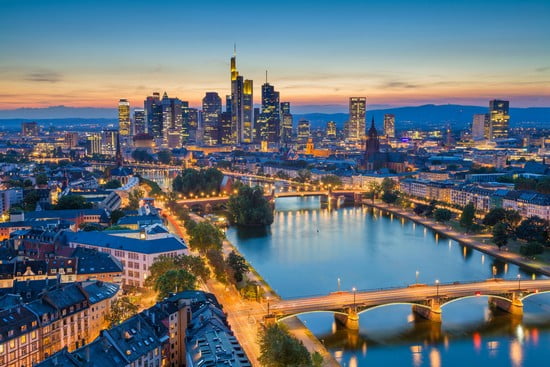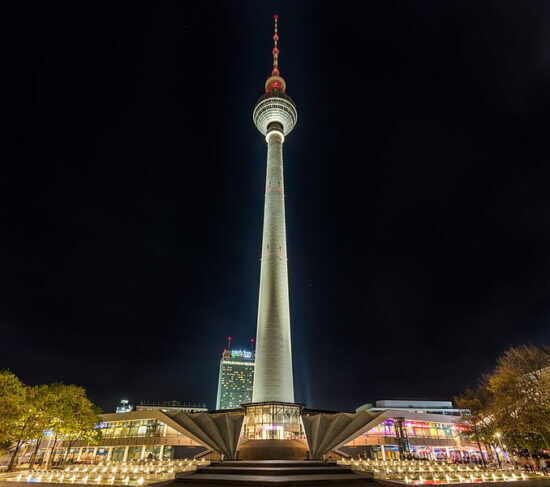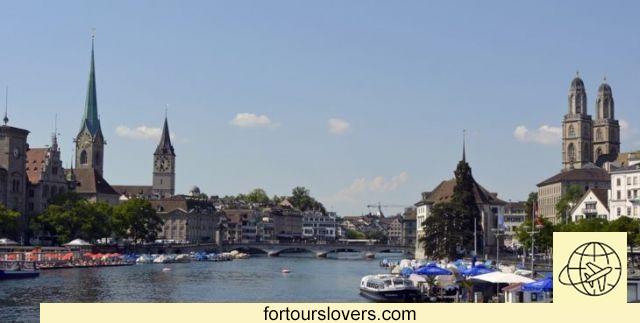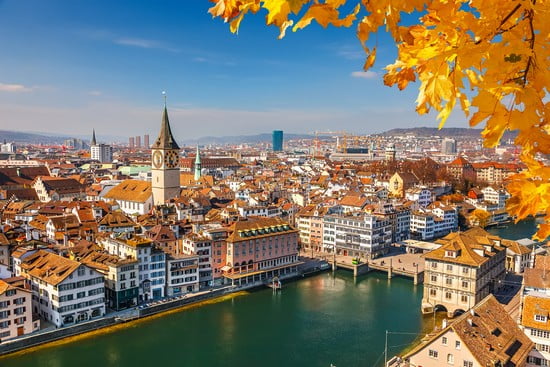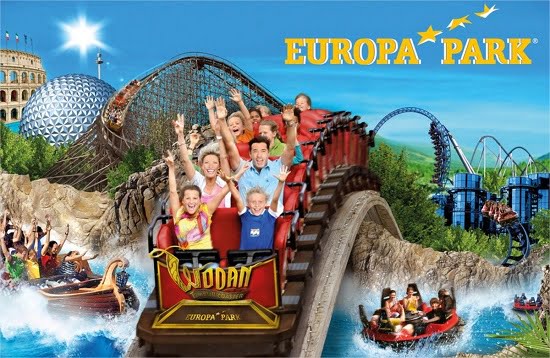Not just the Romantische Strasse in Germany, but all of Bavaria is full of things to see: in those territories, between Swabia and Lower Franconia, there is a familiar atmosphere.
Perhaps due to the fact that already in the first century BC this land was conquered by the Roman legions who inevitably brought with them traditions and customs, of which we can find evidence in the various archaeological finds, in particular in the city of Augusta.
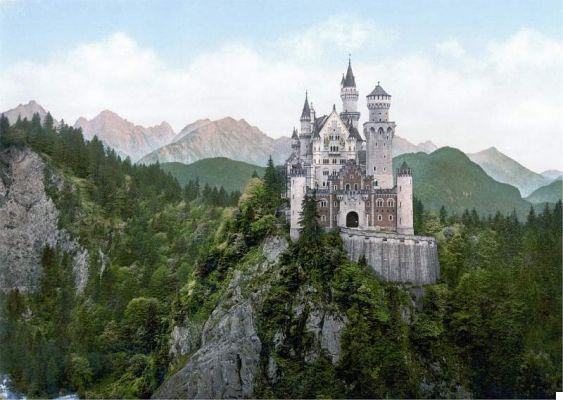
The splendid Schloss Neuschwanstein that inspired Walt Disney for the castles of his cartoons
Another Roman legacy is undoubtedly the cult for the spas, of which the whole region is rich, where the inhabitants spend most of their free time.
Small warning: inside the part dedicated to wellness, such as in Turkish baths and saunas, it is mandatory to enter without a costume, I was walking around wrapped in a towel. On the contrary, in the part dedicated to swimming, it is mandatory to wear it.
Often it is possible to take a bathrobe or towel for hire, but not always, so I suggest you bring microfiber towels or bathrobes, they are light and take up little space in your suitcase.
The harmony between artistic heritage and natural landscapes of Bavaria particularly striking along the Romantic Road (Romantische Strasse), the layout of which is indicated by signs with green writings on a white background,
La Romantische Strasse starts to Fussen, on the slopes of the Eastern Allgäu mountains, where the castles built by Ludwig II stand out against the alpine background, and winds through the Pfaffenwinkel regions, scattered with monasteries, touches the sumptuous Augusta, follow the placida Tauber valley, whose spearhead Rothenburg is the emblem of German Christmas, which can also be enjoyed in summer, and finally arrives in Lower Franconia, a Würzburg, surrounded by vineyards.
reach Bavaria, the most popular routes are through the Gotthard tunnel, in Switzerland, or the Brenner pass, in Austria. We have chosen to cross theAustria, and we bought the Vignette corresponding to the toll on two wheels valid for 10 days at a service area just before the Brenner pass, paying € 5,10.
More info on motorway toll in Austria find them on Austria Tourism website.
In Germany le highways are free and marked with blue signs. The absence of speed limits applies only in the absence of rain, otherwise the limits are indicated by the signs, and in any case the speed of 130km / h cannot be exceeded.
Se travel by motorbike like us, arm yourself with a lot of patience to find officially marked motorcycle parking spaces: apparently not all towns have parking for two-wheeled vehicles and when there are parking spaces, most of the times these are located far from the city center. 'interest.
Everywhere the ubiquitous municipal police do not appreciate the creativity that sometimes distinguishes motorcyclists, handing out hefty fines without too many compliments. This has often forced us to place the motorbike in car parks and consequently pay for the parking time.
As for the food, the offer is very varied and many dishes are cooked in different ways according to the area.
For example, the most popular dish of all is lo roast shank of pork or veal (Haxen) and in the Bavarian Allgäu is accompanied by Spaetzle (traditional homemade pasta).
The Haxen in Eastern Bavaria is instead served with huge spherical potato gnocchi, called Knödel, finally in Franconia the side dish often consists of mushrooms (typically Cantarelli, also called Galletti) and Knödel which here are filled with bread.
Le bakery (bakeries) and the Pastry shop (pastry shops) are great for breakfast or a quick lunch, while for dinner you can opt for guesthouses or pubs, trattorias with local gastronomy.
Pay attention to dinner time: especially in small towns, dinner starts early, around 17:00 pm, and the kitchen closes just as early, usually by 21:00 pm.
Furthermore, the managers are inflexible: in a couple of restaurants we have been denied the possibility to have dinner already at 20:40 pm with the reason that the kitchen had to close at 21:00 pm, so I suggest you start looking for a place already starting from h19: 00.
Itinerary and Map
organize this trip I used the guide Touring Editore Munich and Bavaria which I found really valid, complete; full of useful tips, photos and clear maps essential to find your way around the major centers of interest, and from which I draw inspiration to write this article.
- 1 - Romantic Street
- 1.1 feet
- 1.2 The Castles of Neuschwanstein and Hohenschwangau
- 1.3 Augusta
- 1.4 Donauwörth
- 1.5 Nordlingen, Germany
- 1.6 Dinkelsbühl
- 1.7 Rothenburg ob der Tauber
- 1.8 Würzburg
- 2 - Nuremberg
- 3 - Regensburg
- 4 – Monaco
- 5 - Innsbruck
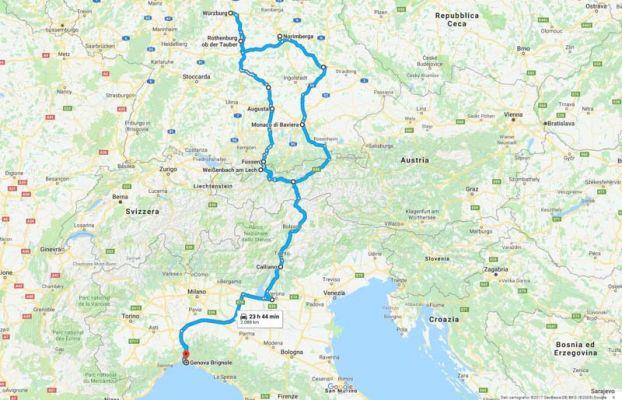
The itinerary in Bavaria of Serena and Marco
To break the 650 km that separate our beautiful Genoa from the Romantische Strasse, we followed one of the most followed criteria, that is: “where it costs less”.
And so the choice fell on the delightful little town of Calliano in Trentino-Alto Adige. The imposing Castel Beseno is the backdrop to this enchanting medieval village.
Second technical stage: Weißenbach am Lech, in Tirolo, almost on the border with Germany, tactically close to Füssen, but much cheaper. Here we took advantage of a discount, given to us by the lady who rented the room, to spend a couple of hours in the spa complex.
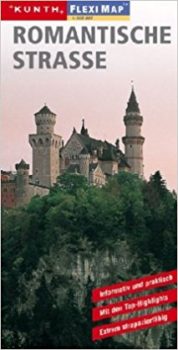
To travel the Romantische Strasse by camper, motorbike (like us) or by car it is also convenient to have this map.
You can find it here on Amazon >> Mappa Romantic Road
Romantische Strasse
Fussen
On the third day we make our entry into Bavaria, starting from the first of the stages of the Romantische Strasse: Fussen.
The pouring rain did not stop us from visiting the Old Town, where the ancient and characteristic houses that belonged to solid merchant families overlook winding alleys that branch off from the equally ancient bread market: the Brotmarkt.
From here, we walked up to theabbey of St. Mang, dating back to 750 AD and then transformed into Baroque forms in the early 1700s.
Market square in Füssen, photocredit @Marco Toni
Hohenschwangau e Neuschwanstein
The queue at the ticket office to visit the castles of Louis II it was infinite: so we gave up the idea of visiting its interiors.
Don't make the same mistake as us: be an early riser and dedicate the whole day to these Bavarian architectural masterpieces, surrounded by a splendid alpine landscape.
Entrance to the parks and gardens of the castles is free, so we were content to admire them from the outside, walking along the road that climbs through the woods, which offers glimpses of the underlying plateau and the lake behind.
Il Castello Hohenschwangau it is the royal residence built by the parents of Ludwig II, the mad king who squandered the coffers of the kingdom to build sumptuous castles (he was obviously a bit of a megalomaniac) certainly inspired by this.
Built in neo-Gothic style on the model of nineteenth-century taste, here the prince spent the holidays with his mother.
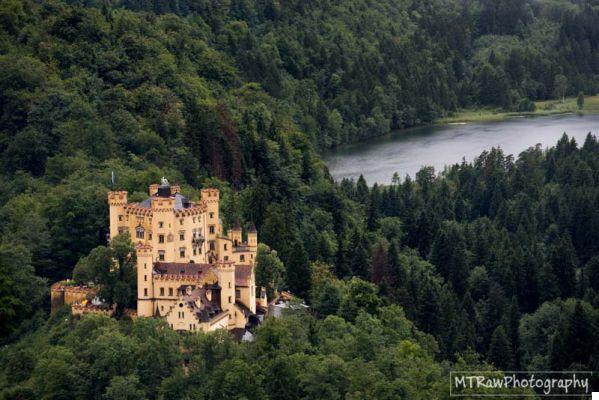
Castello Hohenschwangau
Lo Neuschwanstein Castle among the castles built by Ludovico II, it is the one that best reflects his fairy-tale vision and a dreamer of life.
This fantastic reinterpretation of the medieval architecture of the manor inspired Walt Disney who took him as a model for some of his most famous cartoons.
If you are planning to visit at least 3 of the Bavarian castles and state palaces, I recommend purchasing the corresponding 14-day or annual pass which is on sale at the ticket offices.
Ludwig's famous castles (Neuschwanstein, Linderhof, Herrenchiemsee), The Residenz (Castle in the center of Munich) and Nymphenburg castle to Monaco, the Residence di Würzburg Kaiserburg in Nuremberg and others.
Among the exceptions is Hohenschwangau Castle as it is not state-owned but owned by the Wittelsbachs, the former ruling house of Bavaria.
The pass must be shown each time at the ticket office to be converted into the actual entrance ticket, so it does not enjoy a privileged queue as for online bookings.
My advice is if you have time, di stop at least a couple of days to visit the area thoroughly.
Check here the prices and availability of the hotels near the castles of Neuschwanstein and Hohenschwangau.
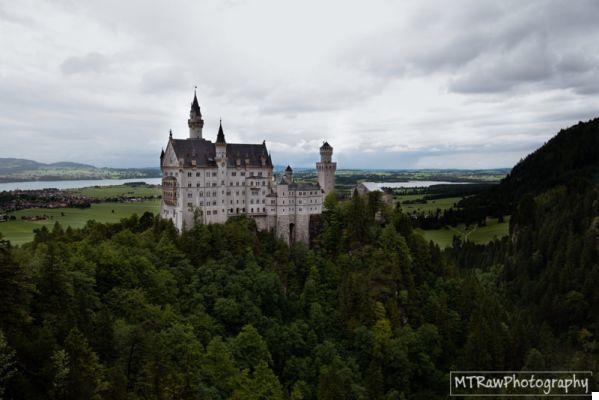
Neuschwanstein Castle or the fairytale castle that inspired Walt Disney
Augusta
The incessant rain dissuaded us from stopping in the following towns and led us to go directly to Augusta, where we stayed overnight. A real shame to have only touched the Santuario In The Wies, a splendid Rococo church that stands in the center of a green lawn, a Unesco World Heritage Site.
Augsburg and the capital of Swabia and boasts architectural testimonies that can compete with the cities, in particular those left by the Fugger, a family of bankers worthy of the Medici competitors on the international financial center of the 500th century.
Il I would run away and the popular sixteenth-century neighborhood that the family built and assigned to the citizens who fell into poverty, perfectly preserved and open to visitors.
Walking through the historic center, surrounded by almost futuristic architecture, you can breathe a pleasant and relaxed atmosphere.
We started from church of St. Anna, we headed to the duomo high cathedral, an imposing two-headed cathedral, surrounded to the south by the ancient field reserved for jousting and tournaments, the Fronhof, continuing to the house of Mozart's father, Mozarthaus, which preserves the relics, paintings and documents of the time.
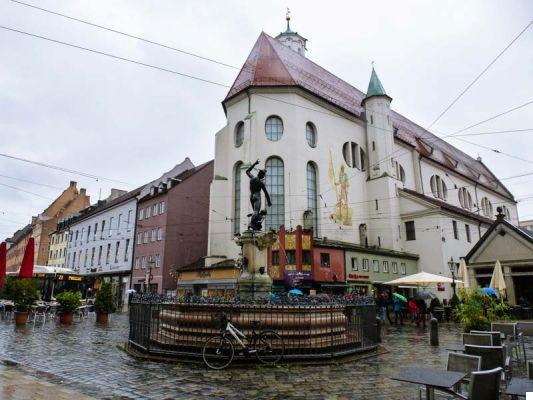
Moritzkirche Church in Augsburg
Donauwörth
Next stop is Donauwörth: a town that was born as a fishing village on an islet of the Wörnitz river and which, by expanding, has maintained the right balance between artistic and naturalistic heritage.
The main street of the beautiful historic center, the Reichsstrasse, is distinguished by the multicolored façades with pediments, among which that of the palace of the Fuggers, the famous merchants of Augusta, the Fuggerhaus.
La Reichsstrasse di Donauwörth
Nordlingen
Approaching Nordlingen, you can see the high belfry tower of Daniel, annexed to the Gothic church St. George, which rises in the center of this town that lies in the circular plain of the Ries, an enormous crater formed following the fall of a meteorite about 15 million years ago.
The best way to admire the intact historic center with an elevated view is to walk the covered walkway placed on the walls that surrounds it, preserving its characteristic circular shape.
La Reimlinger Tor, on the south side of the walls it is particularly imposing and on its left you can admire the bastion of the '600 Alte Basei.
The structure of the buildings in the tanners' quarter is really characteristic Tanners Quarter, with the upper floors open to allow the drying of the hides.
Historic center of Nördlingen
Dinkelsbühl
Also Dinkelsbühl boasts an intact historic center enclosed by walls that can be partly traveled and lapped by the river Wörnitz.
Le typical half-timbered houses and the towers refer to a past made rich by the skill of artisans and merchants, a skill that has led it to be a thriving industrial center to this day.
Square in front of the St. Georg church in Dinkelsbühl
On the square in front of the St. Georg church, with slender Gothic lines, there are various residences dating back to the period between 1400 and 1600, such as the Schranne, an old food warehouse, the half-timbered house German house and a red building that housed the town hall tavern, the Council drinking room.
Rothenburg ob der Tauber
Finally, in the evening, we came to Rothenburg ob der Tauber, an enchanting town not only during the Christmas period, when all the buildings are decorated with illuminated fir branches: at any time of the year it is possible to savor the fairytale atmosphere given by the narrow alleys with the half-timbered houses and the painted facades of bright colors, which give visitors a real leap into the past around the time of the Thirty Years War.
Video game fans, then, will not be able to help but identify themselves in the role of Guybrush Threepwood, hero of the famous game Monkey Island, since the pirate country explored in the first part of the game reproduces many of the streets and squares of Rothenburg.
Also in this case I recommend to walk the perimeter of the old city on the patrol paths of the walls that outline it, thus discovering some of the most characteristic corners and splendid panoramic views from the top of the 43 towers.
There are so many things to see that we stayed here for two nights, in a hotel not far from the walls: Hotel-Gasthof Post.
The area enclosed by the walls is entirely pedestrian. The central square, Marketplace, hosts the Town hall, the imposing town hall that blends two styles: the Renaissance body faces the square while, turning the corner onto the via Herrngasse, shows off the Gothic body with a sixteenth-century tower.
Behind it stands the majestic Gothic building of the St. Jakob church, characterized by mighty buttresses and slender flying buttresses. Although it was summer, we did not miss the opportunity to immerse ourselves in the atmosphere of Christmas anyway.
Crossing the threshold of the shop Kathe Wohlfahrt one has the impression of making a dimensional leap into a parallel world where the Christmas period never ends: four floors of gigantic decorated fir trees, animated plush puppets, decorations of all kinds.
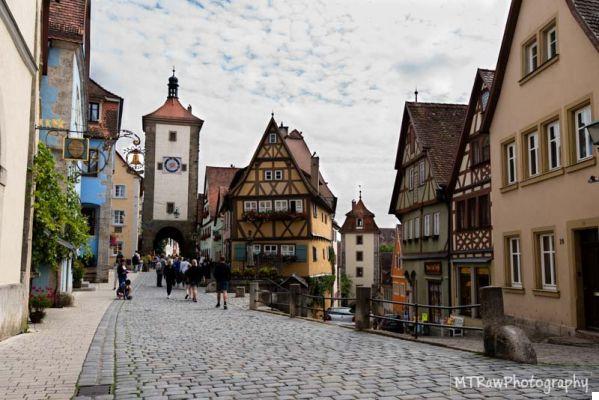
The clock tower known to players of Monkey Island in Rothenburg ob der Tauber
Würzburg
Also to Würzburg a whole day of visit should be dedicated: this lively university city has been transformed from a medieval village to a dazzling Baroque town after the almost total destruction wrought by the Thirty Years War.
It was then again strongly affected by the Second World War, and again completely rebuilt, creating a singular mixture of old and new.
An obvious example can be admired in the central square, the Market, where Gothic stands out among the curtain of modern buildings Marienkapelle, whose bell tower has survived intact to this day.
A few steps away you can admire the Town hall, the town hall, which blends the original medieval parts with subsequent Gothic and then Renaissance extensions.
A sumptuous example of Baroque added to Romanesque, on the other hand, is the spectacular facade of the Neumünster church. These important monuments in the heart of the ancient city center lie between the Main and the sumptuous complex of the Wurzburg Residence baroque, erected in the 700s as the new seat of the principality.
Previously the residence of the bishops-princes was the Marienberg, a mighty fortress dating back to the fifteenth century that overlooks the city from the top of the hill covered with vineyards that rises on the left bank of the Main.
To reach it, cross the river passing over the massif Ponte Old Main Bridge, dating back to the twelfth century adorned with 12 imposing statues of saints.
Il ponte Alte Mainbrücke a Würzburg
Nuremberg
After a hearty breakfast with two nice slices of the delicious Bavarian cakes, we say goodbye to the Romantic Road and we leave for Nuremberg.
Along the way, however, we stop at the Franken-Therme Bad Windsheim GmbH, to spend a few hours of absolute relaxation.
Once in the city, we introduce ourselves to the hotel Ibis Budget Nürnberg City Messe and, after unloading our luggage, we plunged into the visit of the historic center, taking advantage of the efficient public transport service.
The medieval monumental structure of the old city is embraced by a mighty one circle of walls erected between the fourteenth and fifteenth centuries, defended by about 80 towers and 5km long, obviously passable.
Il Pegnitz river separates two neighborhoods.
The first, theAlstadt St. Lorenz, is a southern semicircle that develops in a network of almost concentric streets: Alstadt St Lorenz takes its name from the church dedicated to S. Lorenzo overlooking Königstrasse, the most important artery of the city center.
THEAlstadt St.Sebald it is located on the opposite bank and is the upper half of the historic center.
The historic center is gathered around the church dedicated to the city patron St. Sebald and includes the imperial castle Burg, late Romanesque temple Albrecht Dürer church, the toy museum Spielzeugmuseum, Town hall and other important city symbols.
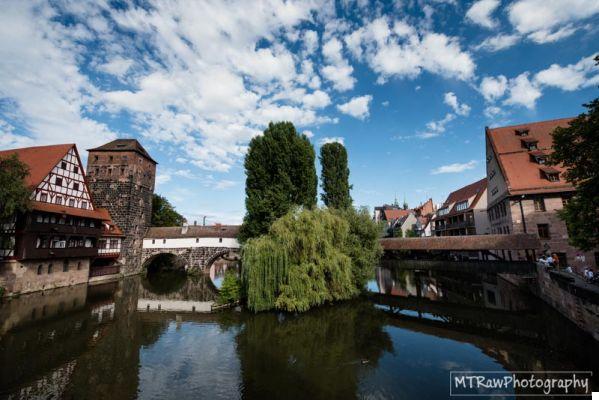
The river Pegnitz in Nuremberg
By a fortuitous coincidence, that day was dedicated to a festival of street artists and musicians: every corner, street, square was invaded by artists of all ages and from the most varied musical genres that merged into an exciting union as they progressed. carried out our path.
Regensburg
Regensburg it has been the center of important trade routes thanks to its port on the Danube which is the busiest in Europe.
Walking through its historic center you can feel the atmosphere of that flourishing past in which the prosperous trade with Venice also allowed it to import its architectural models: paved alleys overlooked by patrician residences and tower-houses painted with delicate pastel tones, while robust arches of Romanesque buildings contrast with the delicate tracery of the Gothic spiers of Dom St. Peter.
The religious area of the city is organized around the cathedral and includes important monuments, including: theOld chapel, court chapel dating back to the early Middle Ages; Niedermünster, church belonging to an ancient monastery, today the Episcopal Palace; the Bischofshof, a building that incorporates on the north side the most important Roman monument of the city: the Pretoria gate.
It is particularly impressive to cross the Danube on the stone bridge Stone bridge, a medieval engineering masterpiece of 16 spans approximately 310mt long.
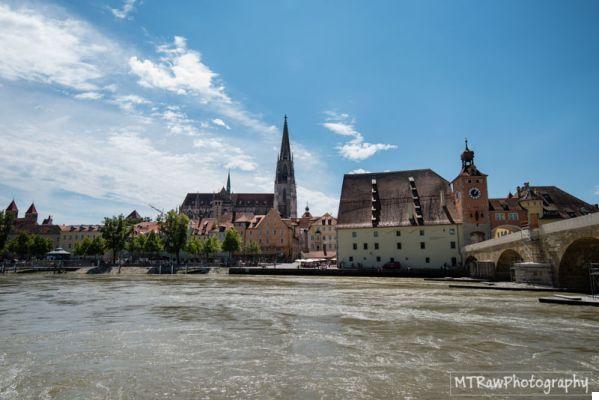
The center of Regensburg seen from the opposite bank of the Danube, on the right the stone bridge Steinerne Brücke.
Monaco of Bavaria
In the evening we arrived at Monaco of Bavaria, where we spent two nights in the hotel LetoMotel Munich City East.
Walking through the streets of the center, you discover a city that has been able to create a happy balance between ancient institutions and industrial expansion, amalgamating the cosmopolitan spirit with the provincial one.
Da Marienplaz, one of the most beautiful squares in Germany, at the center of which rises the column with the golden statue of the Madonna, Marian column, there are several lines full of shops and monuments.
A is extends the Valley, the medieval tree-lined road that heads towards the Isar River, historically rich in inns and taverns.
A west They are Kaufingerstrasse e Neuhauser Strasse, the heart of the ecclesiastical quarter, as evidenced by the numerous religious buildings.
A southwest Sendlinger Strasse touches the Jewish quarter, whose focus is concentrated in St. Jakobsplatz, in which the building of the Synagogue, and ends from the ancient walls, passing them you reach the Theresienwiese park, site of Oktoberfest.
A north Theatiner Strasse leads to Residenz (Castle in the center of Munich), a sumptuous royal residence overlooking the Hofgarten, the court garden.
The historic stage is an essential step Hofbräuhaus beer garden, whose crowded hall on the ground floor evokes the atmosphere of medieval taverns, where we tasted the famous beer accompanied by a gigantic and delicious Pretzel.
Then, how could we BMW centaurs have snubbed the district dedicated to this noble brand?
The four aluminum towers, about a hundred meters high, already shine in the distance and approaching you reach the silver building of the BMW Museum with a futuristic design that is almost reminiscent of a spaceship.
Next to it stands theautosalone BMW Welt, whose shape resembles a lightning bolt that hits the ground; which can be visited free of charge, it offers, in addition to the models for sale of motorcycles and cars: interactive games; driving simulators; demonstration videos and the latest experimental prototypes.
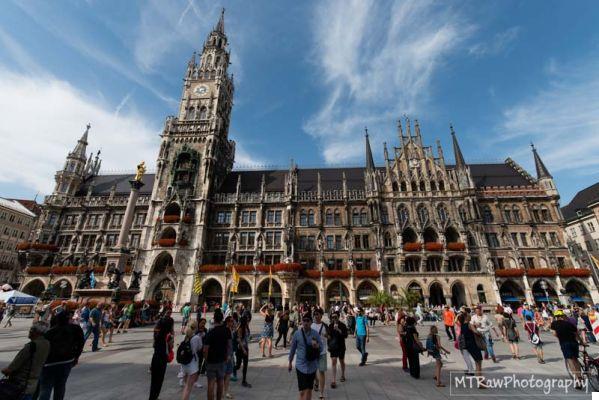
The Neues Rathaus overlooking Marienplatz in Munich
Innsbruck
A Innsbruck we only stayed one night in the campsite Ferienparadies Natterer See, which among the various options also offers nice barrel-shaped bungalows.
Il place is beautiful: immersed in a park of fir trees, it includes a swimming pond with an inflatable water park.
Al Innsbruck's historic center we only spent a few hours: starting with Herzog-Friedrich Strasse, the oldest street in the city Altstadt characterized by arcades and beautiful wrought iron signs typical of Tyrol, you arrive at Goldenes dachl symbol of Innsbruck, known as the Golden roof because it is covered with gold foils.
Next to the Golden Roof is the civic tower Stadtturm and in front of the building Helblinghaus, a beautiful example of rococo and stucco.
The historic road ends at the inn Goldenes Adler inn (Golden Eagle), believed to be the oldest in Austria.
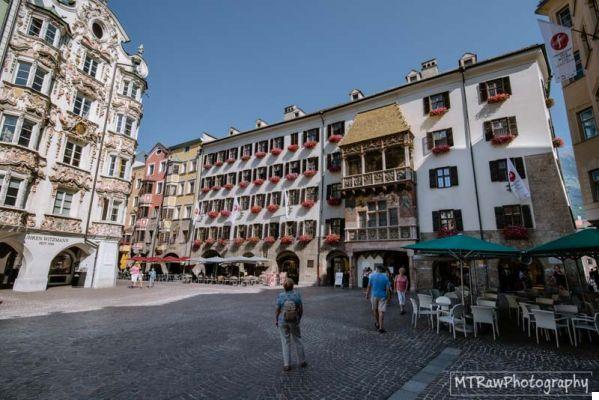
The Golden Roof in Innsbruck
Not only therefore the Romantische Strasse, but Bavaria in general is a region rich in everything you could wish for: art, culture, history, nature, gastronomy, traditions.
The trip was complete from every point of view, apart from the four days of pouring water since we crossed the Brenner.
Therefore, I recommend that you leave equipped with waterproof suits in Goretex: urban ones, in fact, can protect for a few hours, but in the long run they succumb to the violence of the water.
Good Trip!!
